
Lush rainforests. Bird varieties by the 100’s. Enough plant varieties to give a hardcore botanist an overdose. Indigestion?
When moving about in Costa Rica, one thing becomes quickly clear. Despite being as little as 85 miles from the Pacific Ocean on the west coast to the Caribbean Sea on the east, taking in the range of plants and animals found in the different microclimates is like eating at a buffet. Here are a few of the zones:
- Wetlands: If it’s flat, chances are it’s wet, especially in the east. These include grassy marshes and…
- Mangroves: These are swampy areas that support trees and woody plants with fully submerged roots. Mangroves both buffer the shoreline and provide a nursery for hundreds of marine species.
- Páramo: A sort of high altitude wet tundra
- Islands: Most of the offshore islands are protected because of delicate, isolated ecosystems.
- Rainforest: As in, tropical rainforest. Jungle. Bird calls galore. Screeching, howling monkeys. Lions and tigers and – oh, wait, wrong jungle. Costa Rica does have wild cats: jaguars, ocelots, pumas, jaguarundi, and margays, likely in various ecosystems, but it’s unlikely you’ll see them.
- Dry Forest: The Pacific side of Costa Rica is dryer than the Caribbean side, and is home to most of the dry forest. At least, what remains of it; timber and ranching interests have made serious inroads. Fortunately, chunks of that land have been reclaimed by new national parks, and second-growth is starting to fill in. Worth noting: almost a quarter of Costa Rica’s lands are protected in one way or another.
- Gallery Forest: Edge or gallery forest occurs where there’s a gap in the canopy, and the ground and sides of the trees are exposed to much higher levels of sunlight than in an intact forest. This can occur naturally, but a lot is due to clearing for development.
- Cloud Forest: When warm moist air blows in from the Caribbean and gets pushed up the mountains in the central highlands, it cools and forms into mists and clouds. Plants in the cloud forest sponge it up, making for a unique environment.
We hiked the Escalonia cloud forest trail, finding a range of vegetation including many from the bromeliad family, and proof that there is light at the end of the tunnel.
Bromeliads
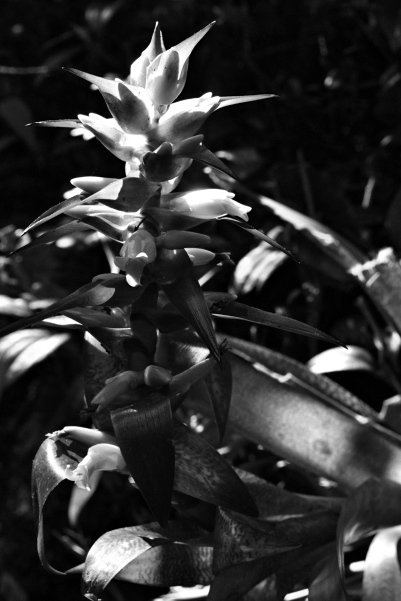
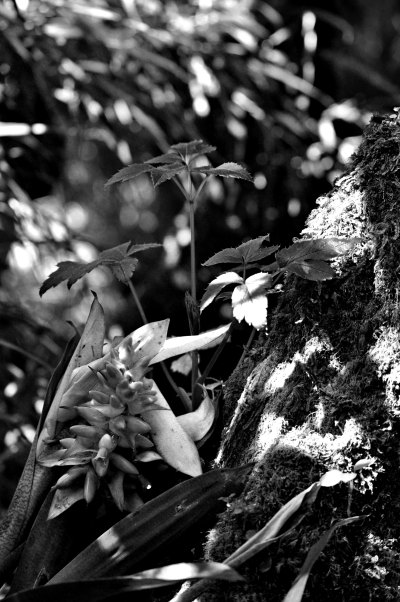
BTW, did you know that pineapple is a bromeliad?
- Volcanoes: With all this blather about plants and animals and ecological systems and life busting out at the seams, you wouldn’t think, “I bet there’s a lot of volcanoes there”, would you? Would you believe 130 plus?
Ok, so only six are active. But tell me, if you were Mother Nature and had a strip of land with an ocean on one side and a sea on the other; a continental plate giving you a shove; a glut of plant and animal life in uncountable varieties festooning your crown; wouldn’t you feel like someone who’s overdone it at the buffet line?
Yeah. Geologic indigestion. Heartburn, enough to heat up groundwater and provide hot springs. Man, having no respect for Mother Earth’s suffering, has turned these hot springs into luxury spas, complete with swim up bars, hot waterfalls, cool off pools, and visions of decadence. These tend to be near Mount Arenal and a tourist town called La Fortuna, as until recently Arenal was giving a safe show from a distance. Man also likes to swing from the trees (ziplines), hang out (hanging bridges), float (white water rafting), bounce off the walls (canyoneering), and more – all this is possible in the land of the turista.
But for Mother Earth and a case of acid indigestion, check out Poas Volcano.
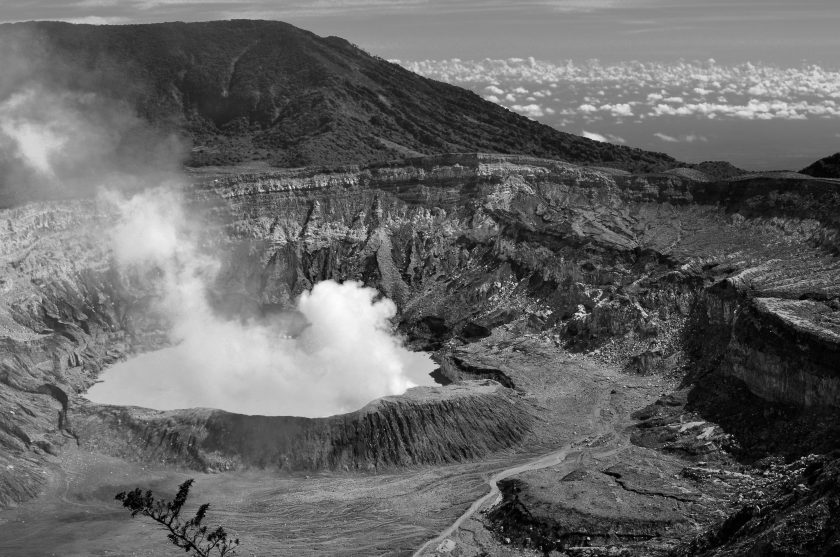
At almost a mile across it’s the largest active crater in the world. Eruptions are geyser-like: water leaks through cracks in the hot rock getting converted to steam – when the steam pressure exceeds the weight of the water in the lake, kablooie!
The lake is rain-fed and is a green, sulfuric, bubbling steam pit, and source of acid mist and rain which stunts and stains downwind vegetation.
At least it wasn’t hurling chunks…
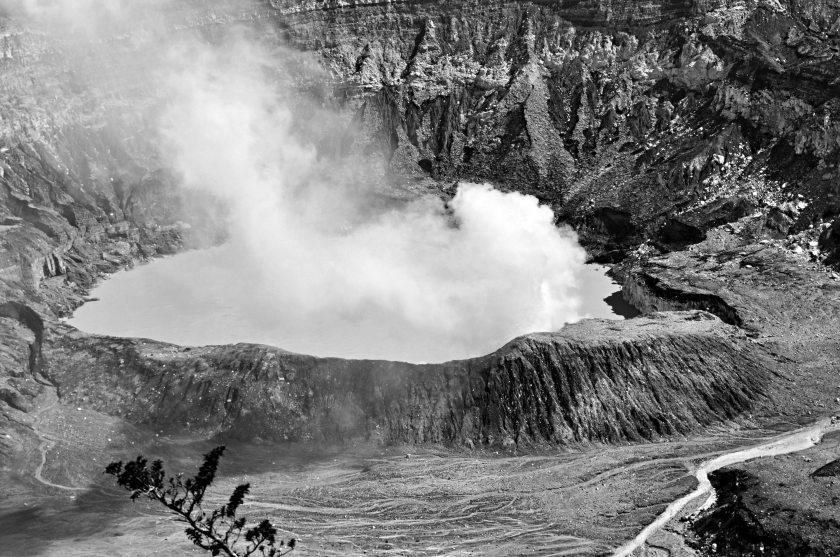
We were lucky to get such a good view. Normally clouds close in the crater in the afternoon, and often in the morning too. Did I mention Poas crater is adjacent to the Escalonia cloud forest trail?
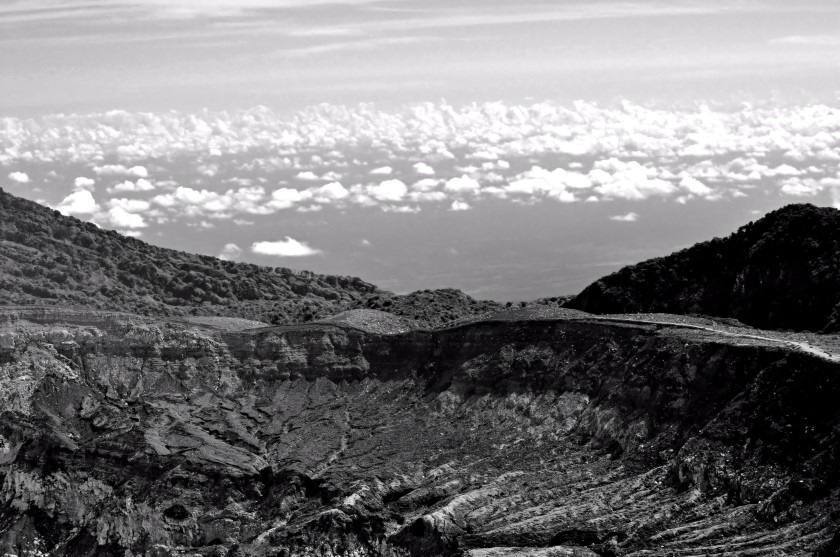
Phew. After all that, maybe a morsel of dessert is called for. Here’s another one from Tortuguero.
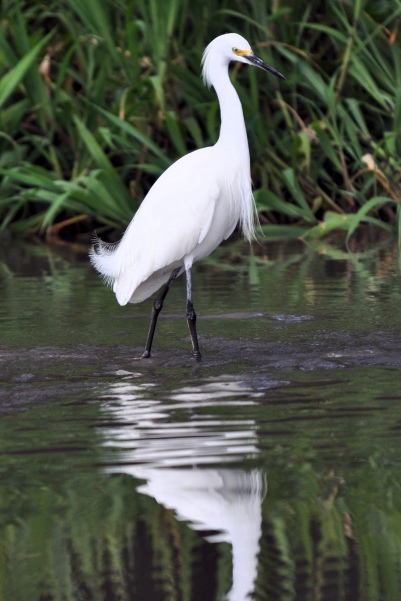
Credit where credit is due: I acquired a lot of this Costa Rica information from a highly informative website: Costa Rica Guide. If you’re considering a trip to Costa Rica it would be a great place to start your research.

Wow, sounds wonderful. Many years ago I was staying in Santiago (Chile) and an Argentino flatmate (what you would call a roomie, I think) just raved about Costa Rica – said it was one of his favourite countries. He was also very fond of England, where he’d lived for a while; he loved English manners.
LikeLiked by 1 person
Yes, it’s an interesting country to see. I’ve actually made two trips there and will likely return at some point. (I think I’ve said that about NZ too)
LikeLiked by 1 person
It’s pretty amazing that all those different micro-climates are all in that small strip of land! Throw in some volcanoes, and whew, it’s a bit intimidating!
LikeLiked by 1 person
Yep, everything from sea level to 10,000 feet. Poas is around 5000 feet. Maritime climates, rain traps, rain shadows.
Of course, Oregon is fairly diverse in that respect as well, albeit across a bigger space, but maybe that diversity helps with the intimidation factor.
LikeLiked by 1 person
It sounds a fantastic place – there, that’s another one you’ve introduced me to! And I just luurve the black and white photos.
LikeLiked by 1 person
The world is full of fantastic places, and you’ve featured a few I’d like to see too.
After the response to the “do you like black and white or color” question I put out there in Cape Crusaders I was determined to put out some more B/W photography. But what in the tropics would serve? I’m glad you “luurved” the choices. 🙂
LikeLiked by 1 person
I’m glad you did, Dave.
LikeLiked by 1 person
It seems there’s an amazing amount of geographical variation packed into a relatively small space. I hope I have a chance to visit it someday. It’s yet another destination to add to my ever-expanding bucket list. Unfortunately, I’m going to have to live to be over 1,000 if I’m ever to have any chance of completing it.
LikeLiked by 1 person
I know the feeling. And what makes it worse is, once you do check a place off the bucket list, you usually end up saying “I want to come back again someday”, and the bucket list doesn’t get any smaller.
LikeLiked by 1 person
That’s very true. 🙂
LikeLike
Wonderful ! Costa Rica seems like a beautiful tourist destination. I love the way you played with the black and white photos. 🙂
LikeLiked by 1 person
Nice place, eh? The last few posts have been on Costa Rica, feel free to see more. The black and white has been more popular than I expected, I’ll being doing more from time to time.
LikeLiked by 1 person
Yeah! It’s really cool.
LikeLike
I really found your post very interesting and I loved the black and white photos, particularly the first one, the light at the end of the tunnel. It’s a place I haven’t been to as yet! Love the title of the post too by the way, it made me want to read your post.
LikeLiked by 1 person
The tunnel shot was pretty good in color, but the b/w conversion made it better. Title’s can be an interesting challenge: how to find something interesting without being blatant clickbait.
LikeLiked by 1 person
I know what you mean about titles. It’s a fine line sometimes.
LikeLiked by 1 person
I’ve never ventured to Central or South America at all; this is a great advertisement for Costa Rica. I like the extended metaphor of ‘indigestion’. Speaking of which, do you write at all about the local foods? That would make great photography.
LikeLiked by 1 person
No, I don’t do stories on the local food, although there might be some interest as Portland has turned into one of those trendy foodie towns that gets national attention.
LikeLike
Great taster for Costa Rica! Loved the feast theme – makes me really feel the abundance of l-nature that you so vividly portray. The B&W photos give it all a bit of an edgy feel -all in all a great read. Thanks for the insight.
LikeLiked by 1 person
Feast of nature – good way to think of it. I took up doing some of the shots in black and white about a month ago, and the response has been so positive I’ll be doing it periodically going forward.
LikeLike
Well that formed a great picture in my mind XD thanks a lot!
LikeLiked by 1 person
Glad to be of service. 😉 Perhaps one of the other posts will help your mental digestion, there’s lots of pretty pictures.
LikeLiked by 1 person
Reblogged this on From 1 Blogger 2 Another.
LikeLiked by 1 person
Thanks Douglas. I’m flattered that you thought to include me. 🙂
LikeLiked by 1 person
Most welcome sir! Very much enjoy your blog and posts!
LikeLiked by 1 person